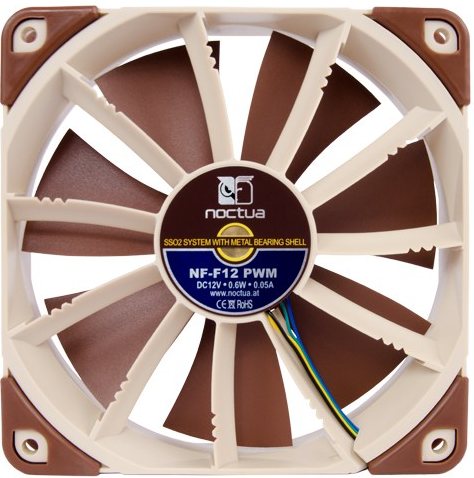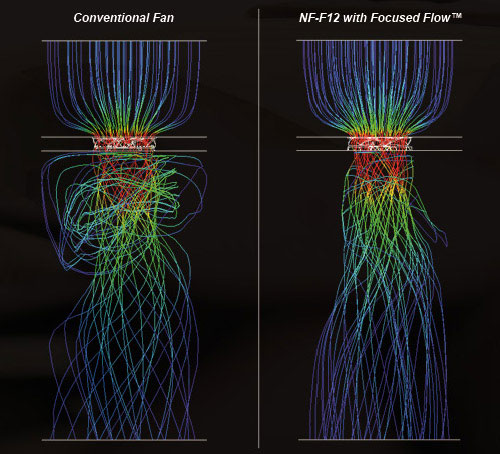Noctua's DH-14: Air Cooling Keeps Up With Liquid?
Additional Fans: The NF-F12 PWM Series
Noctua has a reputation for excellent fans, and our experience with the NF-P12 and NF-P14 that ship with the NH-D14 was first-rate. The company also shipped us a pair of its NF-F12 PWM ultra-quiet fans.

The NF-F12 PWM fan series. Note the stator vanes with their curved notches
These new designs incorporate a number of technologies aimed at improving cooler efficiency and reducing noise. At the heart of the new design is a technology Noctua calls Focus Flow. Focus Flow uses stator vanes to vary air compression across the fan blades as they turn.

This diagram from Noctua is meant to illustrate the benefit of using Focus Flow, but it also demonstrates why adding a second fan to a conventional liquid cooler in a push/pull configuration (as the H100 and H80 do) yields only a small additional improvement. Forcing air over a heatsink creates an area of low pressure directly behind it; the air swirling through this area is called an eddy. Adding a second fan without accounting for the additional turbulence means that a majority of the potential cooling benefit is canceled out.
The company's website details each and every improvement its made to the NF-F12 PWM, including its adoption of a new PWM. We swapped the DH-14's fans for the pair of NF-F12's in our review; comparative results are included in the benchmark data. The DH-14 may be made by Noctua, but it's not necessarily an ideal platform for this type of test. The heatsink's standard fans come with pre-attached clips; we had to finagle the NF-F12's into place to get them to fit. In addition, the extra dampening material around the edges of the NF-F12 fans give them a bit less room when wedged between the two heatsinks.
So, it's expensive and somewhat difficult to install. How's it perform?

The NF-F12 PWM fan series. Note the stator vanes with their curved notches
These new designs incorporate a number of technologies aimed at improving cooler efficiency and reducing noise. At the heart of the new design is a technology Noctua calls Focus Flow. Focus Flow uses stator vanes to vary air compression across the fan blades as they turn.

This diagram from Noctua is meant to illustrate the benefit of using Focus Flow, but it also demonstrates why adding a second fan to a conventional liquid cooler in a push/pull configuration (as the H100 and H80 do) yields only a small additional improvement. Forcing air over a heatsink creates an area of low pressure directly behind it; the air swirling through this area is called an eddy. Adding a second fan without accounting for the additional turbulence means that a majority of the potential cooling benefit is canceled out.
The company's website details each and every improvement its made to the NF-F12 PWM, including its adoption of a new PWM. We swapped the DH-14's fans for the pair of NF-F12's in our review; comparative results are included in the benchmark data. The DH-14 may be made by Noctua, but it's not necessarily an ideal platform for this type of test. The heatsink's standard fans come with pre-attached clips; we had to finagle the NF-F12's into place to get them to fit. In addition, the extra dampening material around the edges of the NF-F12 fans give them a bit less room when wedged between the two heatsinks.
So, it's expensive and somewhat difficult to install. How's it perform?






